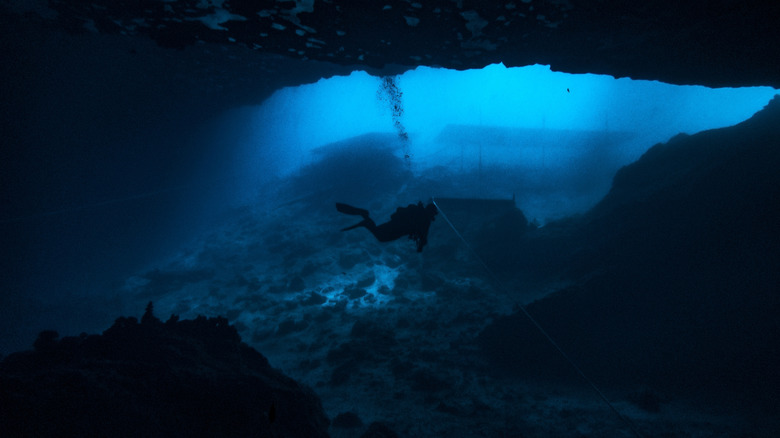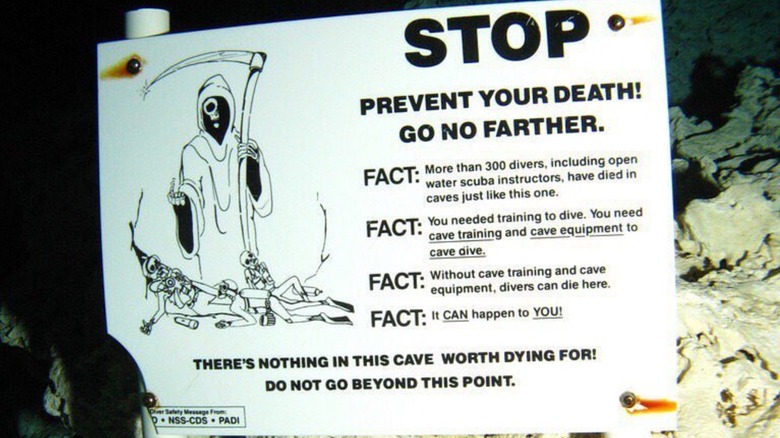This Florida Sinkhole Is A Dangerous Diving Spot That Comes With Death Warnings
Florida is no stranger to dangerous destinations. The state is home to the unexpectedly dangerous city of Boynton Beach between West Palm Beach and Boca Raton. It's where you can also find a scenic lake with a dangerous claim to fame of having Florida's largest population of gators per acre. For many reasons — be it adventure, adrenaline, or a desire to explore the unknown wonders of the world — humans are drawn to these places. These may be some of the reasons why cave divers still flock to the deadly Eagle's Nest, despite more than 10 divers perishing in this deadly underwater cave system since 1981.
Eagle's Nest is a sinkhole located in the Chassahowitzka Wildlife Management Area, near Florida's western coast, about an hour's drive north of Tampa. The dive site, which looks like a placid lake from the shoreline, has earned its deadly reputation as the "Grand Canyon" of diving. This is thanks in part to its considerable depth of 310 feet and challenging labyrinthine system that can be tight and silty, limiting visibility and increasing the risk of accidents. So many tragedies have occurred here that there is now a sign set up just beneath the surface, warning divers not to proceed beyond a certain point or risk death. Despite these warnings and a rather foreboding depiction of the Grim Reaper, people have continued diving Eagle's Nest, with tragic consequences.
In 2013, father and son Darrin Spivey and Dillon Sanchez failed to return to the surface after diving at Eagle's Nest. While Spivey was a certified diver, he was not a trained cave diver, and his son wasn't certified to dive. A few years later, the bodies of Patrick Peacock and Chris Rittenmeyer were found at a depth of around 260 feet. More recently, 20-year-old Said Marjane was recovered in 2018 after he died while free diving with friends.
Safety comes first at Eagle's Nest
Cave diving usually poses more risks than open-water diving, although both have resulted in deaths over the years. Risks include getting lost, overhead obstructions, low visibility, and claustrophobic passages. As the sign at Eagle's Nest (pictured) states, over 300 divers have died in cave systems around the world. However, it is possible to safely dive Eagle's Nest if you follow the right approach and remain considerate of the environmental dangers and your own limitations.
Jill Heinerth, an underwater photographer and experienced cave diver, said in a 2016 National Geographic interview, "Everything from failing to run a continuous guideline ... failing to reserve enough gas, equipment failures, medical problems, loss of visibility from disturbing sediment on the walls, floor, and ceiling of a cave. And of course people go above and beyond their training and experience." That last point is important for people to consider before diving Eagle's Nest. Now, you must show your cave diving certification and go through an official registration before you can dive there.
Registration is free, and without the proper documentation for each dive, you may be fined. The facilities are well-managed, with facilities like drop toilets, picnic tables, a dive logbook, and a boardwalk to the sinkhole. With better practices in place, it's the hope that no more deaths occur at Eagle's Nest so it doesn't have to be closed to the public like it was between 1999 and 2003. As Heinerth stated, "It's not generally the cave that kills people," and for many experienced cave divers, the risks pale in comparison to the wonders they uncover. If you're interested in beginning your diving adventure, check out the cheapest places in the world where you can get scuba certified.

